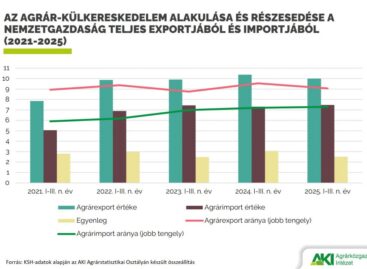Hungary has been in the EU for 20 years: how has foreign trade changed?
On May 1, 2004, ten new states joined the European Union, including Hungary. In our series of articles, we use one indicator to explore how the situation of our country has changed during our 20-year EU membership. The subject of this article is foreign trade.
Hungary is a small, open economy with an export-led growth model. Between 2004 and 2008 – in just 4 years – the volume of domestic exports doubled. In the following period, however, we felt the downsides of exposure to international economic processes: as a result of the 2008 financial crisis, domestic product and service exports decreased by 22% in 2009. After the recovery from the crisis, exports essentially stagnated in the first half of the 2010s, and by the end of the decade, Hungarian exports were on a growth path again, which was interrupted in 2020 by the coronavirus crisis. This was followed by a strong rebound over the next two years. Overall, the domestic export volume increased 2.6 times between 2004 and 2022, which is an impressive result in itself, but not by any means in regional terms. The Slovaks increased their exports by 2.9 times, the Czechs by 3.2 times, and th
Related news
Agricultural foreign trade surplus decreased in the first three quarters of 2025
🎧 Hallgasd a cikket: Lejátszás Szünet Folytatás Leállítás Nyelv: Auto…
Read more >Perceived price increase index remains high
🎧 Hallgasd a cikket: Lejátszás Szünet Folytatás Leállítás Nyelv: Auto…
Read more >The GKI business climate index closed 2025 at a one and a half year high
🎧 Hallgasd a cikket: Lejátszás Szünet Folytatás Leállítás Nyelv: Auto…
Read more >Related news
Christmas shock in commerce: for the first time, we can pay with bank cards in fewer places
🎧 Hallgasd a cikket: Lejátszás Szünet Folytatás Leállítás Nyelv: Auto…
Read more >Hungarian Confectionery Manufacturers Association: trends in 2025 and prospects for 2026
🎧 Hallgasd a cikket: Lejátszás Szünet Folytatás Leállítás Nyelv: Auto…
Read more >Most grocery chains will be open until noon on December 24th
🎧 Hallgasd a cikket: Lejátszás Szünet Folytatás Leállítás Nyelv: Auto…
Read more >






